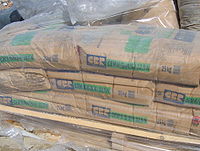Paper bag
This article needs additional citations for verification. (September 2011) |
A paper bag or paper sack is a preformed container made of paper, usually with an opening on one side. It can be one layer of paper or multiple layers of paper and other flexible materials. A bag is used for packaging and/or carrying items.
Single layer

Paper shopping bags, brown paper bag, grocery bags, paper bread bag and other light duty bags have a single layer of paper. A variety of constructions and designs are available. Many are printed with the names of stores and brands. Paper bags are not water proof. Types of paper bag are: laminated, twisted, flat tap. The laminated bag, whilst not being totally waterproof has a laminate that protects the outside to some degree.
Multiwall paper sacks

Multiwall (or multi-wall) paper sacks or shipping sacks, are often used as shipping containers for bulk materials as fertilizer, animal feed, sand, dry chemicals, flour and cement. Many have several layers of sack papers, printed external layer and inner plies. Some paper sacks have polyethyelene foil or polyethylene coated paper layer in between as water-repellant barrier.
There are two basic design of bags: open mouth bags and valve bags. Open mouth bag is a tube of paper plies with only one bottom end sealed by the paper sack producer. The bag is filled though the open mouth and then closed by stitching, adhesive, or tape. Valve sacks have both bottom ends closed and are filled through a valve. A typical example of valve bag is the cement sacks.
Recycling
Paper bags are readily recyclable. Plastic or water-resistant coatings or layers make recycling more difficult.[citation needed]
History
Margaret E. Knight (1838-1914) was an employee in a paper bag factory when she invented a new machine part to make square bottoms for paper bags. Knight can be considered the mother of the grocery bag, she founded the Eastern Paper Bag Company in 1870. On 20 February, 1872, Luther Crowell also patented a machine that manufactured paper bags.[1]
See also
References
- ^ Petroski, Henry (2004). Small things considered. New York: Vintage. p. 106. ISBN 1-4000-3293-8.
Books
- Yam, K. L., "Encyclopedia of Packaging Technology", John Wiley & Sons, 2009, ISBN 978-0-470-08704-6
